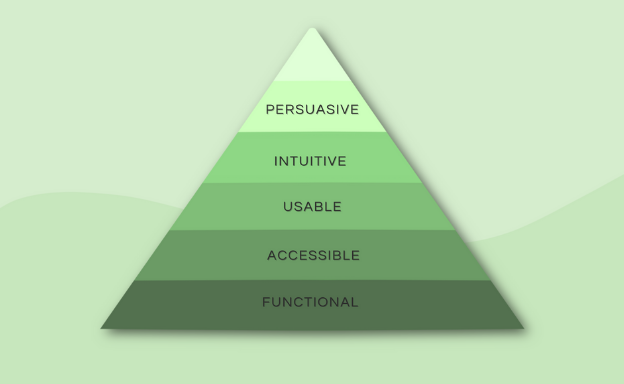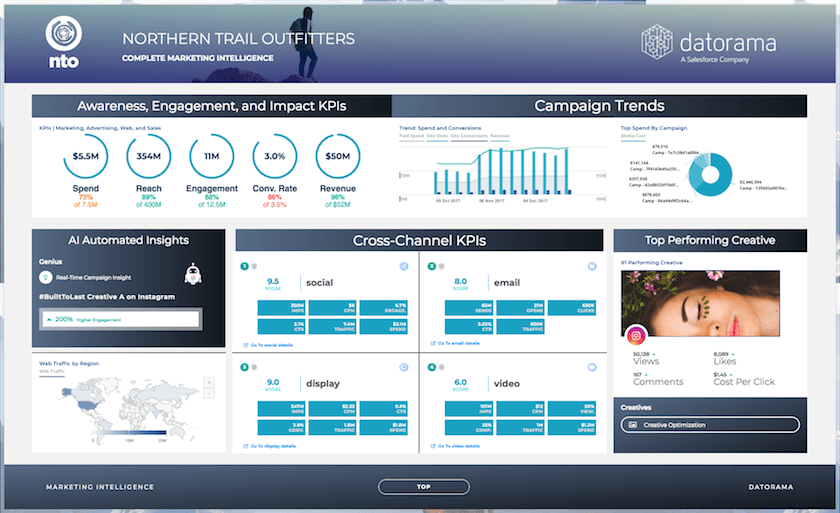
A Complete Guide to Advertising Analytics
Advertising analytics have changed right alongside advertising mediums. And yet, many businesses are leaving money on the table by using outdated ways of measuring success.
So, how can marketers modernize their advertising analytics analysis to make changes where needed and remain competitive?
In this article, we’ll walk you through the basics of advertising analytics and how to leverage them as a key component of a modern marketing strategy.
Table of contents
What is advertising analytics (and how it can help you improve results)
Advertising analytics refers to the data marketers collect specific to how their advertising performs across channels and campaigns.
Advertising specifically refers to paid media and is different from earned or owned content, such as press, your website and blog, and social media.
Because there will always be spend behind advertising (you can’t do it for free), it’s crucial to pay attention to how different ads perform. This may sound obvious, but it’s easy for marketing teams to get caught up in trends and a “what’s always worked for us” mentality.
Let’s say a software company allocates a budget to Instagram ads, for example. While Instagram is a really effective place for some brands to spend money, when professionals are on this platform, it’s usually for personal reasons.
Therefore, even if you’re targeting a professional marketer on Instagram with a highly relevant marketing analytics tool, they may not be in the right headspace to pay attention to something work-related.
It’s important to test and learn what works best for your company’s product or service so you don’t have to spend more than is necessary on advertising. The goal is ultimately to increase conversion rates (and decrease spend) from your team’s paid media efforts.
To help build a solid foundation for ad measurement, here are some advertising analytics terms you’ll want to understand and initially track.
Cost per action (CPA)
This refers to how much money it costs for a potential customer to complete your ad’s call to action. A good CPA maximizes profit; a bad CPA may cost as much as the product you’re selling. If it costs as much to produce the product as it does to get a customer to click on your “Buy now” button, your CPA is too high.
Cost per action (CPA) is calculated as the cost divided by the number of actions being measured.
So if you spent $1,000 on an ad campaign and there were 25 actions taken on your ad, your CPA would be $40.
Return on ad spend (ROAS)
Overall, how much return on investment (ROI) did you see from a given campaign or budget? This metric measures the amount of revenue earned for every dollar you spend on advertising.
When calculating ROAS, you divide the total value of all conversions on the ad by the cost to run the ad. So, if you earned $200 on $20 of ad spend, your ROAS would be $10.
Another way to look at it is for every dollar you spend on ads, you get $10 back.
Click-through rate (CTR)
This metric determines at what rate people are clicking through your ad. It can help determine the most effective messaging and is a great place to A/B test different messaging.
For example, let’s say you test two types of messaging: one is a five-star review from another customer; the other is a 10% off discount. You may notice that the review gets much more attention than the discount, which can help your team lean into social-proof messaging.
To calculate your CTR, divide the number of clicks that your ad receives divided by the number of times your ad is shown. In other words, clicks divided by impressions equals your CTR. You then multiply this number by 100 to get a percentage.
So, if you had 50 clicks and 1,000 impressions, your CTR would be 5%.
Cost per click (CPC)
This refers to how much you pay for every click on an ad. Depending on the platform you’re using, you may have an actual CPC, an average CPC, and a max CPC. This is because some ad platforms try to continually optimize your audience to bring down your cost (such as Facebook).
An actual CPC is how much it is currently costing you per click. An average CPC is how much it’s costing you on average per click. And the max CPC is the maximum amount you’re willing to pay for a click (it’s something you decide before running the ad, and it tells the platform where the outer limit is).
To calculate your average CPC, divide the total cost of your clicks by the total number of clicks. So, if you spent $50 on ads and received 25 link clicks, your CPC is $2.
Cost per 1K impressions (CPM)
This one is a hot topic among marketers because you aren’t guaranteed clicks with CPM advertising. It can, however, help with brand awareness because it guarantees to at least show your ad to X number of thousands of people.
Always keep in mind that while these metrics do have value, they should always be considered in the context of your overall business goals and the key performance indicators tied to those goals.
An excellent first step toward mastering advertising analytics is understanding what you’re looking for and determining what types of advertising data your team is already tracking. This is most easily done when your data is centralized.
Get ahead by centralizing your marketing data
Most businesses need omnichannel marketing to thrive. Because of this, it’s easy for this data to live in silos. The first step toward getting your analytics in order is centralizing your advertising and marketing data.
Before implementing any new strategy—whether it’s paid, earned, or owned—we always recommend housing your data in one place to get more out of your analytics.
You may have data in separate analytics platforms like Google Analytics, within a mobile app, in your CRM, or other marketing platforms. For advertising specifically, this can get complicated when different teams are responsible for different budgets.
For example, suppose your social media team handles paid social spend, a growth team is responsible for ads that appear on search engines, an SEO team bids on keywords, and a content team handles advertorials.
Since advertising analytics are mostly quantitative, you’ll want each team to think through where that data lives and how it can be centralized. We recommend importing these data sets into a single data platform and then organize by campaign type, date, and channel or team.
There are several ways to do this. To begin with, you can use a comprehensive tracking convention for a tool like Google Analytics, or whatever web analytics platform you use. Then, you can move into using a tool like Salesforce’s Datorama to align data across multiple channels. You will eventually want to mature to the point where this data is being housed in a data warehouse, so you can analyze it in much more robust ways using tools like Tableau or Domo.
Once you can see the data side by side, you can begin to build synergy between channels, teams, and strategies.
Top Tip: Wish your data could do more? Learn how to get greater intelligence from your marketing analytics 🐼
Understand omnichannel interplay by getting smart on attribution
Once your data is centralized, and analytics data is funneling into one location, you can attribute leads and sales to different marketing activities.
More importantly, you will start to see and understand the interplay between them. You may even be surprised by the marketing performance of an activity or initiative you previously weren’t paying much attention to. Marketers often see this with offline campaigns because it’s typically much easier to perform data analysis when activities are all online.
Let’s say you run an offline marketing campaign that includes impressions-based subway ads in New York City. While we know that it can be difficult to directly attribute offline impressions to revenue, you can look at what else is happening.
You may notice a surge in organic searches within a 10-mile radius of the neighborhood where the ad ran. You may also notice a surge of new social media followers based in New York City or a jump in revenue out of New York.
You can see how in this example, it’s important to not only track direct revenue but also the customer journey coming out of different marketing channels and initiatives.
In summary, look at your campaign performance in aggregate. This is because the people visiting your website and following your brand on social media are now a part of your marketing funnel, and the goal is that they will eventually convert into paying customers.
With this information, you may start a retargeting campaign or digital marketing campaign specifically to this new audience segment. Tracking advertising as a part of your overall marketing is important in understanding how all of the moving pieces come together.
Optimize and refine your marketing strategy
With your analytics centralized and a clearer understanding of attribution, it’s time to optimize your marketing strategy based on your data.
You can follow these five levels of ad optimization to make sure you’re running ads effectively.

1. The functional level. Check your ads are running properly and make for a good user experience. At this stage, address basic functioning questions like:
- Does the creative match the copy?
- Is the CTA button working?
- When a lead clicks on the ad, does it route to the correct page?
2. The accessible level. Make sure everyone in your audience can access your ads. At this stage, address issues like:
- Are my ads responsive on mobile?
- Is the page they route to responsive on mobile?
- Is the copy in the creative legible for everyone?
3. The usable level. Ensure your ad delivers a positive user experience. Now that you have united your data, you are better positioned to analyze ads at these deeper levels of optimization. At this stage, ask questions like:
- Is this ad relevant to the target audience?
- Is it non-intrusive (e.g., it doesn’t auto-play sound)?
4. The intuitive level. Check that your ads match the user journey stage. Make sure it’s using the right message at the right time for your buyers. This will depend on the type of ad you’re running (top-of-funnel, middle-of-funnel, or bottom-of-funnel). At this stage, ask questions like:
- Does this ad incorporate the pain points my audience is feeling at this stage in their journey?
- Does this ad use their words in the messaging (and not corporate-speak if you’re targeting non-corporate professionals, for example)?
- Does this ad effectively capture the audience’s attention in the headline and creative?
5. The persuasive level. In the final level of optimization, you want to make sure your ad is doing its ultimate job: communicating your offer. At this stage, try to remove any remaining friction and ask questions like:
- How can I make this ad more enticing?
- What might be stopping the audience from clicking?
- What might be stopping the audience from converting on the landing page?
- Are there any critical benefits that we haven’t made obvious?
Once you’ve come up with some ideas for how to optimize your ads, you can begin to test iterations to see if they improve your KPIs.
“Business Wargaming” is a method that essentially stimulates different tactical, operational, and strategic decisions within your advertising landscape to see what might perform best, along with when and where. It gamifies the optimization process and lets you see advantages and disadvantages before making investments.
You may test different types of messaging within the same demographic or region, pitting strategies against each other and seeing which comes out on top.
Having your data centralized will help your marketing team make better decisions regarding optimization and refining strategies. Those changes may mean updating messaging, shifting gears, or allocating time and resources somewhere else entirely, which we’ll get to next.
Allocate budget and resources with confidence
In some ways, allocation is the fun part of advertising analytics. You’ve done your due diligence in getting organized, and now it’s time to spend your budget with confidence.
Your marketing team and all relevant stakeholders should now be on board with your decision-making because they’ve had access to tests in real-time via your centralized marketing dashboard (i.e. where your data lives). When everyone has visibility into how previous ads have performed, it’s much easier—and requires much less convincing—to all get on the same page regarding future budget spend.

Having real-time access to advertising analytics also means your team should be willing and prepared to be agile and make updates to the plan as frequently as needed.
For example, let’s say one of your digital advertising keyword campaigns is running perfectly until a competitor ups their bid for the same word. Or, maybe a current event happens within your industry, rendering your previously resonant messaging irrelevant or even offensive.
While the numbers can tell marketers a large part of the story, we still need humans—with all the emotional intelligence, nuance, and context they bring—to help interpret the data and tweak plans accordingly.
Especially if you’re at a large company, you may have so much data that human interpretation becomes increasingly difficult. Larger companies may benefit from using predictive analytics to make intelligent predictions based on patterns and permutations.
It may be this type of system that helps a marketing team see the connections in the New York City subway ad example. Getting clear on allocation is also important at larger companies, where many teams may be involved in executing different advertising and marketing activities.
To continue with the subway example, it may be easy for a team focused on out-of-home or experiential marketing to claim success. Just as easily, a team bidding on new, relevant keywords based on the real-time data they’re seeing from people searching after seeing the subway ad might claim responsibility.
Likely, both teams deserve credit (and budget to keep doing what they’re doing). Centralized and thorough analytics can help attribute success to the right teams and activities.
Wrapping up
Today’s marketers sometimes have more data than they know what to do with. That’s why it’s important to centralize your advertising data before determining next steps.
It’s also important to get clear on which questions you want to both ask and answer with your marketing analytics. From there, you can optimize your ad campaigns and allocate budget and marketing efforts accordingly.
The most successful marketing teams will continue to revisit and reevaluate their advertising analytics without fear; agility is critical to success. Having clear visibility across your marketing team and organization will help you make efficient and strategic decisions that will benefit the organization’s bottom line.
READY TO PROVIDE A BETTER POST-CLICK EXPERIENCE?
Get insights and tips to drive more business from less ad spend, more profit from less cost, and more customer value from less churn.